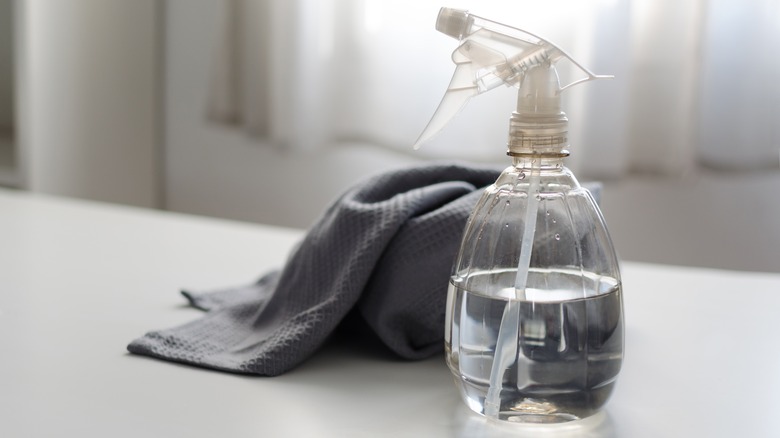Can You Use Vinegar To Strip Paint From Wood For Your Next DIY Project?
DIY woodworking projects are a great way to revamp old thrifted furniture or repurpose weathered wood pieces you might already have in your home, and paint stripping is often part of the preparation process. If you are working with a used wooden piece, it may have chipped paint that needs to be removed. The item may even simply be painted a color you don't like and need to switch out. Traditional paint stripping products often emit strong fumes, so many DIY enthusiasts turn to natural alternatives to help strip paint, like vinegar. Unfortunately, this common household ingredient is unlikely to get the job done.
The problem with vinegar is that it's not quite strong enough to thoroughly strip paint off of wood. Although the substance can help loosen paint, it's not ideal for removing paint on its own and would need to be used alongside other types of paint removal methods. If you attempt to use it as a paint remover, you will likely be left with patchy, partially stripped paint instead of bare wood. Rather than helping you prepare your wood for sanding and repainting, this would complicate the process. It may even cause you to resort to a traditional paint-stripping product in the end.
Why vinegar is not ideal for paint stripping
Some DIY enthusiasts do use vinegar as part of their paint-stripping process, but it is not all that effective. This method involves creating a paint-loosening solution using one part vinegar and two parts water. This liquid makes it easier to remove paint by softening it, but it still requires you to scrape or sand away stubborn spots. Vinegar simply is not as strong as other types of paint remover, so it does not yield the same results.
Although vinegar is not the best option for removing paint from your woodworking projects, you can use it to help simplify clean-up. Its paint-loosening abilities are helpful for removing stubborn drops of paint from your floor. If you have ever done a painting project indoors, you might be familiar with how frustrating it can be to deal with these unsightly drips. You can use the previously mentioned vinegar solution to make these spots easier to remove. This is a better use for the substance that is more likely to be effective. However, vinegar should not be used on hardwood floors; make sure you can safely use vinegar on the flooring in your home before trying this method.
Better ways to strip paint from wood
Although vinegar cannot be used as a standalone product for paint stripping, there are other alternatives that can help you get the job done effectively. For example, there are some household ingredients you can use to strip paint from wood, like baking soda. Soy-based paint strippers are another option. The Soy-Gel Professional Paint Remover, sold by The Real Milk Paint Co. for $22, is a low Volatile Organic Compound (VOC) alternative to traditional paint stripping products. The soy-based paint remover does not emit strong fumes and can be used on wood. Unlike vinegar, it was specifically formulated to be used as a paint stripper, so it is more effective.
The EcoFast 100G GEL Paint Stripper sold by Eco Safety Products for $55 is another alternative to traditional paint strippers. It has a low odor and is free of Methylene Chloride and NMP. It is also safe to use on wood. This paint stripper works differently from other products because rather than dissolving paint, it soaks through the substance's coating to break the bond. It is also thicker than many paint removers. This means it is easier to work with than other thin, runny formulas. These alternatives allow you to enjoy the same low-fume and environmentally friendly benefits of vinegar. Despite their heftier price tags, they are far more effective at stripping paint and will provide you with the results you're looking for.


